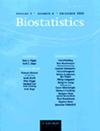Dynamic and concordance-assisted learning for risk stratification with application to Alzheimer's disease.
IF 2
3区 数学
Q3 MATHEMATICAL & COMPUTATIONAL BIOLOGY
引用次数: 0
Abstract
Dynamic prediction models capable of retaining accuracy by evolving over time could play a significant role for monitoring disease progression in clinical practice. In biomedical studies with long-term follow up, participants are often monitored through periodic clinical visits with repeat measurements until an occurrence of the event of interest (e.g. disease onset) or the study end. Acknowledging the dynamic nature of disease risk and clinical information contained in the longitudinal markers, we propose an innovative concordance-assisted learning algorithm to derive a real-time risk stratification score. The proposed approach bypasses the need to fit regression models, such as joint models of the longitudinal markers and time-to-event outcome, and hence enjoys the desirable property of model robustness. Simulation studies confirmed that the proposed method has satisfactory performance in dynamically monitoring the risk of developing disease and differentiating high-risk and low-risk population over time. We apply the proposed method to the Alzheimer's Disease Neuroimaging Initiative data and develop a dynamic risk score of Alzheimer's Disease for patients with mild cognitive impairment using multiple longitudinal markers and baseline prognostic factors.应用于阿尔茨海默病风险分层的动态和一致性辅助学习。
动态预测模型能够随着时间的推移而不断变化,从而保持准确性,这对于临床实践中监测疾病的进展具有重要作用。在长期随访的生物医学研究中,参与者通常通过定期临床访问和重复测量进行监测,直到相关事件(如疾病发作)发生或研究结束。考虑到纵向标记中包含的疾病风险和临床信息的动态性质,我们提出了一种创新的一致性辅助学习算法,以得出实时风险分层评分。所提出的方法无需拟合回归模型,如纵向指标和时间到事件结果的联合模型,因此具有理想的模型稳健性。模拟研究证实,所提出的方法在动态监测患病风险和区分高危和低危人群方面具有令人满意的性能。我们将提出的方法应用于阿尔茨海默病神经影像倡议数据,并利用多个纵向标记和基线预后因素为轻度认知障碍患者建立了阿尔茨海默病动态风险评分。
本文章由计算机程序翻译,如有差异,请以英文原文为准。
求助全文
约1分钟内获得全文
求助全文
来源期刊

Biostatistics
生物-数学与计算生物学
CiteScore
5.10
自引率
4.80%
发文量
45
审稿时长
6-12 weeks
期刊介绍:
Among the important scientific developments of the 20th century is the explosive growth in statistical reasoning and methods for application to studies of human health. Examples include developments in likelihood methods for inference, epidemiologic statistics, clinical trials, survival analysis, and statistical genetics. Substantive problems in public health and biomedical research have fueled the development of statistical methods, which in turn have improved our ability to draw valid inferences from data. The objective of Biostatistics is to advance statistical science and its application to problems of human health and disease, with the ultimate goal of advancing the public''s health.
 求助内容:
求助内容: 应助结果提醒方式:
应助结果提醒方式:


